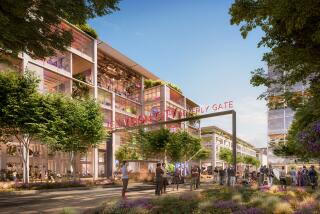Can big names and big money make the Grand a great civic place?
- Share via
After more than 15 years, the Grand — the final piece of Bunker Hill’s transformative Grand Avenue Project — is finally showing signs of life.
According to current plans, the $1-billion-plus development, designed by Frank Gehry and developed by Related Cos. and set directly across the street from Gehry’s Walt Disney Concert Hall, will, by 2021, contain a residential tower, a hotel, 176,000 square feet of shopping and dining, and a public plaza that spills onto Grand Avenue.
Gehry, as is his specialty, has sketched riotous buildings that dialogue with his billowing concert hall, stirring up magnetic energy and stepping down to the street like slightly off-kilter play blocks. The 20-story Equinox Hotel will be clad in gleaming metal, like Disney, with a staggered pattern of windowpanes. The 39-story residential tower will have a more conventional facade, composed of precast concrete panels punched with windows and lightened in sections with glass corners. In between these bookends, the stepped, horseshoe-shaped plaza will be lined with glossy retail spaces.
FULL COVERAGE: Grand Avenue project »
Related Senior Vice President Rick Vogel calls this approach, softened in places with trees and other landscaping, an “urban room,” connected to the street and filled with benches, pathways, stairs, bridges, art, graphics, open-air dining and space for live performances. Its centerpiece is a huge crinkled glass and bent-steel fish sculpture on the second level, designed by Gehry.
Gehry describes the design process as a kind of “gerrymandering,” in which he carved away at his initial design and the developer’s strict design formulas to create what he believes is a more public-oriented project.
“It took us some time to understand each other,” says Gehry, who pushed for opening views to the concert hall across the street and creating a busy, egalitarian outdoor experience.
It’s about putting fingers on that community.
— Frank Gehry
Another major victory for the architect was opening the plaza eastward to Olive Street, allowing for a winding, downhill cityscape that will probably connect to yet another Gehry project — a planned extension of the Colburn School containing new performance venues, classrooms and student housing.
The Grand Avenue Project, first pursued by a city and county body called the Grand Avenue Joint Powers Authority, includes land parcels on either side of upper Grand Avenue. Whereas the Grand has long been held up by financing issues, the other sites have been built out with projects that include Arquitectonica’s $120-million Emerson apartment tower and Rios Clementi Hale’s $50-million Grand Park.
Staring at this avalanche of design talent and funding begs the same question you can ask for the area at large: Can big names and big money make the Grand, and Grand Avenue in general, a great civic place?
The question is particularly relevant on the heels of Related Cos.’ most recent urban effort, New York’s Hudson Yards, which has been widely criticized as a placeless fortress for the elite. Both Gehry and Related are adamant that their efforts will be more effective. Their work so far seems promising, but there are reasons to be concerned.
There is no doubt that Gehry’s designs will draw people to the Grand and encourage them to stay. And thanks in part to requirements set by the Joint Powers Authority, the development should be more connected and egalitarian than Hudson Yards.
The housing tower, like the Emerson, will contain 20% affordable housing (apartments reserved for those making less than the state’s median income), and the retail and restaurants will interact with the street and, according to Related, will contain offerings aimed for a mix range of incomes and cultures. The same authority bargained for Related to fund Grand Park — thus far the Grand Avenue Project’s biggest victory in terms of promoting civic life. Vogel says his company — and a committee of representatives from local companies and institutions — hopes to channel that park’s energy into the grounds in and around the Grand, through, for instance, projections onto Disney Hall, outdoor concerts and street festivals.
Yet the Grand, despite its high aspirations and positive achievements, appears to be a development for the very rich. In order for formulas that Gehry mentioned to pencil out, its exterior surfaces will surely be cheaper than those inside its luxury lodgings and commercial boutiques. (The hotel’s metallic wall, for instance, is painted aluminum, not the stainless steel employed at Disney.)
It seems likely that the more affordable restaurants and shops will play second fiddle to the lucrative brands and “celebrity-chef-driven concepts,” as Vogel puts them. Parking will be under the building, encouraging visitors to stay on the property, not explore the area. These types of inevitable corporate demands are what keep even the best-intentioned developer projects from becoming true civic projects.
Despite its recent triumphs, particularly Grand Park and the Broad, the thoroughfare’s overall streetscape and pedestrian environment is still woefully underdeveloped. Although the street’s biggest booster, Eli Broad, once said Grand Avenue was going to be the Champs-Élysées of Los Angeles (he said years later that he “misspoke”), upper Grand hardly contains any of that Parisian street’s trees, planters, active storefronts, porous building edges, street furniture, sculpture, public transit, public amenities and pedestrian activity. And thanks to plans implemented decades ago, its mix of uses still lacks the variety that a vibrant cityscape needs.
The city is now mandating that developers liven up the streetscapes around new projects here, but that won’t affect the (largely moribund) areas in front of existing buildings. Gehry is attempting to provide some assistance, he says, discussing with Related and city officials the idea of installing more food and beverage offerings on Disney’s ground floor and stimulating the area around it with urban furniture, performance spaces and still more eating and drinking options, including a crystalline bar.
“So far everybody is saying the right things,” he says, adding, “I don’t think special has to be expensive.”
Gehry, who has taken a keen interest in urban-scale projects around the city later in his career, is right about that. In addition to a revamped pedestrian infrastructure, what this street full of elite institutions, elite residents and big-name architecture is missing most of all is some of the cheap, nimble, ad hoc urbanism — murals, pocket parks, swap meets, guerrilla furniture, food trucks, pop-up shops and so much more — that makes Los Angeles such a weird, special place.
“It’s about putting fingers on that community,” says Gehry, who first rose to fame employing just this kind of design. That, after all, is what a civic space is all about.
More to Read
The biggest entertainment stories
Get our big stories about Hollywood, film, television, music, arts, culture and more right in your inbox as soon as they publish.
You may occasionally receive promotional content from the Los Angeles Times.










